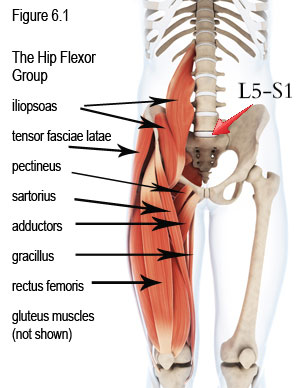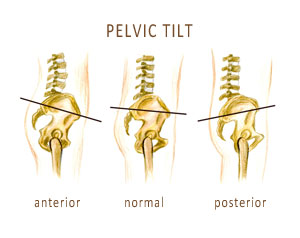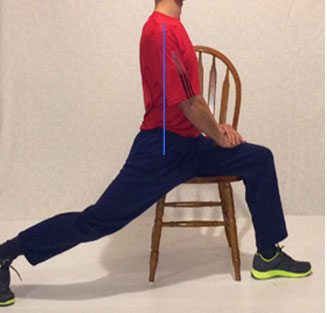Are Tight Hip Flexors Causing Your Pain?

By Sherwin Nicholson | SN Health Resources | Updated May 1, 2020
Follow these 2 easy exercises now for relief
To go to the exercises: Skip to the bottom (but please read on to understand the underlying problems).
It is very common to have hip flexor pain. Most of us can suffer from it, especially while at work.
Your hip flexors are the deeper muscles of the body which are responsible for bending at the waist and for raising your leg. The primary ones being the Psoas Major and the Iliacus. They are commonly referred to together as the Iliopsoas muscle.

By bending at the hips while using these muscles, this prevents you from bending with the lower back.
Unfortunately, most people have poorly conditioned hip flexor muscles and prefer to bend or lean with their lower back. This is further worsened when the hamstrings are both tight and short.
If you are having a lot of problems doing this, it’s not just from the flexors, it’s because your hamstrings are likely preventing you from doing it. This is BAD and is a big source of what it hurting you now. This restricts how well you can flex at the hip to protect your spine.
MUSCLE ISSUES
When your hip flexor muscles have become weak and poorly conditioned, you are no longer able to maintain a straight and aligned posture from your back to your pelvis.
There should be very little movement between the natural curve of the spine concerning the pelvis. This is to preserve the healthy distribution of weight on the lumbar discs. The discs which are most prone to injury are the discs closer in proximity to the pelvis (ex. L5-S1).
Tightness not only contributes to disc injury but also become very sore, causing tenderness, discomfort, and stiffness. We tend to believe that we are sore simply due to the added weight from sitting directly on the muscles themselves or pain due to overuse.
PAIN FROM SITTING AND STANDING
Excessive sitting contributes to tightness and hurts the hip muscles. Sitting causes these muscles to relax and deactivate (zero contractive force) causing a painful condition called adaptive shortening They become progressively weaker and shorter.
This leads to their tightening. Without exercise, they also become smaller in size. Exerting force (muscle contraction) on a muscle which is both tight, short and weak results in an uncomfortable cycle that can be difficult to identify and overcome.
Standing after long periods of sitting causes injury to your lumbar spine. One of the most important flexors, the psoas major muscle becomes chronically shortened and pulls on the lumbar spine (from the hip joint) while in the standing position.
 Symptoms of lower back pain become more apparent when this occurs. Due to the soreness that occurs when standing, one finds it more preferable to sit to alleviate this soreness. Your pelvis tends to tilt forward causing an anterior pelvic tilt. This excessive, abnormal tilt creates imbalanced pressure on your discs and facets joints. This increases the likelihood of a possible disc tear or herniation.
Symptoms of lower back pain become more apparent when this occurs. Due to the soreness that occurs when standing, one finds it more preferable to sit to alleviate this soreness. Your pelvis tends to tilt forward causing an anterior pelvic tilt. This excessive, abnormal tilt creates imbalanced pressure on your discs and facets joints. This increases the likelihood of a possible disc tear or herniation.
A deeper soreness is felt directly from the Psoas Major and Iliacus muscle itself due to the tightness, weakness and sustained pull on this muscle while standing. If it hurts you towards the top of your thigh it is sometimes due to tightness in the Rectus Femoris.
To effectively have relief, learning to stretch the right way is vital. However, stretching in combination with glute muscle stretching is more beneficial.
These other muscles such as the hamstrings, quadriceps, and abdominals are the first to relax well before the hip flexors themselves. Consequently, they are also the first to fatigue, thereby limiting your ability to stretch properly. Treating these neighboring muscles may allow you to feel better, but since your flexors are not stretched sufficiently, you may begin to hurt again.
Does it hurt when you sit in the office? Follow these 5 important tips At Work now.
EXERCISES FOR YOUR HIP FLEXORS
Two excellent exercises are the SEATED LUNGE and the SEATED LEG TO CHEST movement. These two exercises can be performed together while sitting such as during work breaks.

Both exercises will stretch and strengthen your hip and glute muscles. Your gluteal muscles are your primary hip extensors. It is important to incorporate them into this stretch because they are antagonistic to your hip flexors. This allows them to relax naturally to relieve chronic tightening in order to improve the effect of the stretch.
The images demonstrate the final position of each movement. Learn about the SEATED LUNGE and SEATED LEG TO CHEST to get the full description of how to perform each movement.

By stretching these muscles, you can immediately reduce the pain and to lengthen them to a more optimal state needed. It will also feel better as the tension from standing relieved. It is important to also follow a strengthening program combined with stretching as stretching only partially responsible.
For more helpful stretches and strengthening techniques, see EXERCISES FOR LOWER BACK RELIEF.
These exercises are ideal for you if it hurts while sitting. They are great for hip flexor and glute discomfort.
In order to fully appreciate the exercises, try the SEATED LUNGE and SEATED LEG TO CHEST to learn more about how to properly execute them. A more detailed explanation can be found in the program.
Browse the site to learn about your back and to order an effective EXERCISE PROGRAM.
